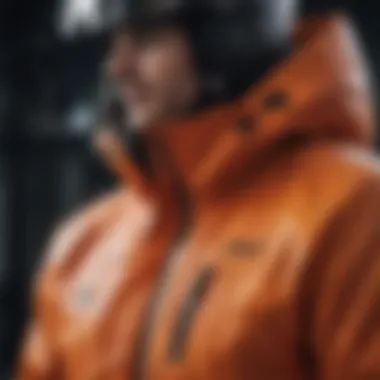The Ultimate Guide to Men's Snow Jackets


Intro
When winter rolls around, snow jackets become an essential item for any man ready to hit the slopes or trudge through knee-deep powder. These jackets aren't just about looking good; they serve a practical purpose, protecting you from the icy elements while ensuring you maintain comfort and warmth. Let's face it, there’s nothing quite like the chilling sting of cold air while you’re stranded on a mountain. That's why understanding the nuances of snow jackets is crucial for anyone who sees winter as an opportunity for adventure.
From the type of insulation used to the waterproofing technology woven into the fabric, it’s easy to get lost in the multitude of options available in today’s outdoor gear market. The goal of this guide is to simplify that selection process. Here we’ll delve into materials, styles, and essential features that make a jacket suitable for various snow sports.
Snow jackets have advanced significantly over the years, incorporating the latest innovations to enhance performance. So whether you’re a seasoned skier or a newbie just strapping on your boots, knowing how to choose the right jacket is vital. Beyond mere aesthetics, factors such as breathability, fit, and durability should guide your decision-making process.
Before we dive deeper, it’s worth noting that snow jackets can’t be viewed in isolation. They are just one component of a complete winter gear setup. Therefore, this guide will also touch on complementary gear and safety measures, ensuring you are well-equipped for your winter endeavors.
So, bundle up and prepare to explore the intricate world of snow jackets designed specifically for men. You'll come away not only informed but also ready to make decisions that could enhance your winter experience tenfold.
Understanding Snow Jackets
Snow jackets stand as pivotal gear for men who venture into the snow-laden wilderness for sport or leisure. Knowing what a snow jacket is, its purpose, and its applications can significantly enhance one's winter experience. It’s not merely about picking up any coat off the rack; it’s about understanding specific features tailored for varied snow sports and weather conditions. A properly chosen snow jacket can make the difference between comfort and discomfort, exhilaration and misery, ultimately influencing a day spent outdoors.
Definition and Purpose
At its core, a snow jacket is designed to protect wearers from extreme winter elements. It encompasses insulation for warmth, waterproofing to repel moisture, and features that ensure breathability to prevent overheating during vigorous activities. The purpose isn’t limited to warmth; it also involves mobility and flexibility to allow athletes to perform at their best. Think of it as a fortress against the unforgiving cold, while still offering the freedom to slide down slopes or climb steeper mountains.
Snow Sports Applications
Understanding the applications of snow jackets can illuminate the best options based on activities. Whether hitting the slopes or embarking on a chilly hike, intrinsic elements define the ideal jacket for your adventure needs.
Skiing
Skiing demands specific features from a snow jacket. One key characteristic is the focus on waterproofing, as skiers often encounter wet snow or slushy conditions. Jackets for skiing are crafted with durable outer layers that resist water intrusion while maintaining warmth. A unique feature of these jackets often includes extended backs to keep snow from sneaking up during tumbles. This makes skiing jackets a popular choice for thrill-seekers looking to zip down steep terrains with an assurance that they’ll stay dry and warm even in challenging conditions.
Snowboarding
Snowboarding offers its own flavor of adventure, necessitating different design details. A typical characteristic is the emphasis on flexibility and stretch, allowing riders to perform daring tricks and maneuvers. Many snowboarding jackets come with unique features like wrist gaiters to block cold air and snow while you wipe out—a common occurrence for many. These jackets are designed to take a beating, often featuring reinforced seams, making them favorable for adventure seekers who embrace the unpredictability of the slopes.
Mountaineering
When it comes to mountaineering, the jacket becomes a crucial part of one’s survival gear. The unique conditions faced at higher altitudes require jackets that prioritize insulation and wind-resistance. A mountaineering jacket often includes specifics like an adjustable hood to fit over a helmet, crucial for those who scale steep faces or traverse icy paths. This specialty gear stands out due to its versatility, being as effective on a challenging ascent as it is during a leisurely trek around a snow-covered village on a frosty day.
General Winter Use
Not all snow jackets are geared towards extreme sports. Many are designed for general winter use, catering to the everyday man braving chilly temperatures. The key characteristic is versatility; these jackets often blend style with practicality for daily tasks. While not specialized, they typically possess features like ample pockets for everyday essentials and locality-appropriate insulation levels. They serve as an excellent option for guys who want to stay warm while running errands or heading out for a casual stroll, offering comfort without compromising on style.
"Choosing the right snow jacket can set the tone for your entire winter experience. It’s about merging functionality with personal style for the best of both worlds."
Understanding these fundamental elements forms a robust foundation for choosing the right snow jacket, ensuring that each outing is met with the utmost enjoyment and safety.
Key Features of Snow Jackets
When it comes to navigating snowy terrains, the features of your snow jacket can make or break your experience. Each element, from insulation to breathability, plays a key role in how well you perform in cold conditions. Understanding these features helps you make informed decisions, ensuring that you stay warm, dry, and comfortable while tackling the slopes or hiking in the winter wilderness.
Insulation Types
Insulation in a snow jacket is vital for retaining warmth. Here we discuss two primary types: down and synthetic insulations, each with its unique characteristics and benefits.
Down Insulation
Down insulation consists of the soft, fluffy undercoating of goose or duck feathers. Its primary appeal lies in its exceptional warmth-to-weight ratio. When you think of cozy jackets that feel like you're wrapped in a warm embrace, down is often the go-to.
The key characteristic of down insulation is its ability to trap heat effectively. This makes it a popular choice among skiers and snowboarders looking for that extra warmth on frigid days.
However, down has a unique feature that can also be a disadvantage: it loses insulating properties when wet. Thus, while down jackets are incredibly warm, they require care to ensure they stay dry—something that could be a dealbreaker if you often find yourself in wet conditions.
Synthetic Insulation
Synthetic insulation, on the other hand, is made from man-made materials designed to mimic the properties of down. It has a leg up in wet conditions since it retains warmth even when damp. This aspect is particularly appealing for those engaged in activities like mountaineering, where conditions can change rapidly.
The key characteristic of synthetic insulation is its resilience and moisture management. Given that it dries faster than down, it stands as a beneficial option for those facing unpredictable weather.
One potential downside, however, is that synthetic jackets can be bulkier and heavier than their down counterparts. While they maintain performance in snow and rain, they may not offer the same lightness and packability—a consideration for minimalists.
Waterproofing Technologies
Waterproofing is another cornerstone feature of snow jackets. Without proper protection against snow and moisture, even the best-insulated jackets can lead to discomfort.
Membrane Materials
Membrane materials are the secret sauce behind waterproof jackets. These materials have tiny pores that are smaller than water droplets but larger than water vapor, allowing moisture to escape while keeping rain and snow at bay.
The key characteristic of membrane materials, like Gore-Tex or eVent, is their reliable waterproofing capability without sacrificing breathability. This makes them a popular choice for those undertaking strenuous activities in wet environments.


However, these membranes can be pricier than other options, and while they perform excellently, the choice really depends on your specific needs and budget.
Water-Resistant Coatings
In contrast, water-resistant coatings provide a less robust form of protection. These are chemical treatments applied to the outer fabric of the jacket. While they can repel light moisture, they typically lack the durability and effectiveness of membrane fabrics.
The key characteristic of water-resistant coatings is their lightweight nature. This makes them a beneficial choice for those who need more portable clothing for activities that might not require full waterproofing.
One downside here is the longevity. As these coatings can wear off with time, regular maintenance is crucial to ensure they hold up against the elements.
Breathability Factors
Breathability is paramount in snow jackets. A jacket that traps moisture can lead to a clammy feeling and reduced performance.
Venting Systems
Venting systems in a snow jacket facilitate airflow. Think of them as your jacket’s way of breathing. Features like pit zips allow you to control your temperature easily.
The key characteristic of effective venting systems is adjustable airflow, which you can tailor to your level of exertion. This makes them a beneficial feature for those who transition between high and low activity levels.
However, if the jacket is constantly venting, it might reduce the warmth when you're not moving, which can be a double-edged sword.
Moisture Wicking
Moisture-wicking technology moves sweat away from your skin to the outer surface of the fabric, where it can evaporate. This keeps you dry and comfortable, an absolute must in snow sports.
The key characteristic of moisture-wicking fabrics is their ability to manage perspiration efficiently. This makes them a popular choice for intense activities, providing comfort during long periods of exertion.
However, quality can vary among different brands, so it’s crucial to choose wisely, as low-quality materials can lead to a soggy experience.
Fit and Mobility
Fit is another critical factor. A well-fitting jacket allows for better movement and layering, directly influencing warmth and performance.
Athletic Cut vs. Regular Cut
Athletic cut jackets offer a streamlined fit, designed to stay close to the body while allowing for movement. This fit is essential for reducing wind drag during activities.
The key characteristic here is that athletic cuts tend to be more form-fitting, making them a beneficial option for those who value agility in their movements. However, some might find this fit restrictive, especially when layering.
On the other hand, regular cut jackets offer more room. While they may feel bulkier, they are versatile for various body types and are easier to layer underneath.
Layer Compatibility
Layer compatibility examines how well your snow jacket works with other clothing. A jacket that allows for effective layering can help you adjust to varying conditions.
The key characteristic of good layer compatibility is its adaptability. This means you can easily layer on insulation or wicking layers without feeling cramped. This is a beneficial choice for those seeking versatility in their wardrobe.
However, not all jackets offer this flexibility, which could limit usability across different weather conditions.
Through understanding these features, you equip yourself to choose a snow jacket that aligns with your adventures. Making the right selection guarantees warmth, comfort, and performance, enhancing your winter experience.
Selecting the Right Snow Jacket
Getting the right snow jacket is crucial for anyone planning to take to the slopes or simply venture into winter’s frosty embrace. Choosing the right jacket goes beyond just picking a stylish outer layer; it can make all the difference when it comes to comfort, safety, and overall enjoyment. The proper selection means you are set for whatever nature throws at you, whether that’s icy winds or unexpected snow flurries. Here, we unpack what you need to consider when shopping for a snow jacket.
Assessing Your Needs
Intended Activities
When it comes to snow jackets, what you plan to do heavily influences your choice. Skiing may require a different set of features than, say, snowboarding. For instance, if you’re hitting the slopes for downhill skiing, you might prioritize a jacket with a more tailored fit for aerodynamic movement. On the other hand, a snowboarder will benefit from a looser style to allow for more dynamic movements on the board.
- Key characteristic: Each activity has unique requirements. Skiers often need jackets with additional waist gaiters to keep the snow out, while snowboarders may look for jackets with longer lengths to ensure coverage while seated.
- Unique feature: The versatility of a good snow jacket lies in its adaptability. Check for features such as pocket placements or leash attachments for different gear which can enhance the jacket’s utility.
However, bear in mind that specific designs can be beneficial to one snow sport and disadvantageous to another. Take the time to analyze how each intended activity informs your choices in material, fit, and durability.
Weather Conditions
The weather can turn in a blink, making the jacket’s performance in various conditions paramount. If you’re planning on enjoying high altitudes or areas known for their unpredictability, you'll want to be armed with a jacket that can handle both warmth and moisture.
- Key characteristic: This means focusing on those jackets equipped with top-notch waterproofing technology, like Gore-Tex or similar membranes, ideal for wet snow or rain.
- Unique feature: Look for jackets that boast heat retention features while maintaining breathability. The combination helps to regulate body temperature, keeping you warm without turning you into a sweaty mess after intense runs.
Ultimately, the ability of the jacket to withstand challenging weather presents a significant advantage. Assessing your snow jacket against the elements helps direct your spending toward a piece that will last through the season and keep you comfortable, regardless of the forecast.
Budget Considerations
Premium vs. Affordable Options


When it comes to budget, there’s a wide spectrum between premium and affordable snow jacket options. Premium jackets tend to integrate advanced materials and technologies that help enhance performance and durability. These can withstand the trials of extreme weather and frequent use.
- Key characteristic: Investing in high-quality snow jackets often pays off; they are designed to last longer and function better with various technologies that keep you comfortable.
- Unique feature: However, premium doesn’t always guarantee perfection. Some features might be overkill for casual winter outings, leading one to wonder if the investment matches the intended usage.
On the flip side, affordable options have come a long way, often providing decent performance at a fraction of the cost. They’re particularly beneficial for beginners or those looking to dabble in snow sports without making a hefty commitment.
All told, budget plays a significant role in what you might ultimately purchase, but it doesn't have to be a simple choice between the expensive and the cheap; look for that sweet spot where quality and affordability intersect.
Popular Brands and Their Offerings
When it comes to snow jackets, not all brands are created equal. The right jacket can make the difference between a day of enjoying fresh powder and being uncomfortably cold or wet. In this section, we will explore several popular brands and their standout offerings. Each brand has carved out a niche that caters to specific needs or preferences, providing benefits that matter for men engaged in snow sports.
High-End Brands
Arc'teryx
Arc'teryx is synonymous with high-performance outerwear. Known for its commitment to quality, this brand often showcases technical precision in its design and manufacturing. One key characteristic of Arc'teryx is its use of advanced materials, which provides exceptional durability and weather protection. This brand appeals to serious skiers and snowboarders who expect nothing less than top-notch performance from their gear.
A unique feature of Arc'teryx jackets is the use of GORE-TEX fabric, which offers reliable waterproofing without compromising breathability. This means you’ll stay dry from both snow and sweat, a vital aspect for anyone active on the slopes. However, the only drawback here is the price point—these jackets can be on the more expensive side.
The North Face
The North Face has built a solid reputation over decades, being a go-to name for outdoor enthusiasts. Their jackets often meld functionality with style, making them popular not just in winter sports but also in everyday wear. A striking feature is their ThermoBall technology, which provides excellent insulation while remaining lightweight—making it a favorite amongst those who ski or hike in colder conditions.
What sets The North Face apart is its wide variety of options catering to different activities, ensuring that everyone finds something fitting their needs. Although the quality is excellent, some users might find certain models not as tailored for performance-heavy activities compared to brands focusing solely on snow sports.
Patagonia
Sustainability is at the core of Patagonia's mission, making it an appealing brand for eco-conscious consumers. Its jackets are known for long-lasting durability and a commitment to responsible sourcing. The brand frequently incorporates recycled materials in its products, which is a distinct advantage in today’s market.
One unique offering from Patagonia is the No technology, ensuring waterproofness and breathability alike. While this is fantastic for those looking to minimize their environmental impact, it’s worth noting that some users may need to pay a premium for the eco-friendly initiative.
Mid-Range Choices
Columbia
Columbia strikes a balance between performance and affordability. Their jackets are designed with innovative features like the Omni-Tech system, providing waterproof protection while allowing body vapor to escape—keeping you comfortable during outdoor activities.
A noteworthy advantage of Columbia is the wide range of options available at various price points, suitable for those just beginning in winter sports or for casual outings. However, some might contend that the insulation could be less effective than high-end alternatives, making it less ideal for extreme conditions.
Marmot
Marmot is well-regarded for its attention to detail and robust designs—popular among those who enjoy snow sports. Their jackets often feature down insulation, known for its excellent warmth-to-weight ratio, allowing for easy mobility without compromising warmth.
The unique feature of Marmot’s range is the use of treated down, which helps maintain loft and warmth even when wet. Many find Marmot's jackets comfortable and reliable; however, like with other mid-range options, they might not match the advanced waterproofing capabilities of higher-end brands.
Outdoor Research
Outdoor Research channels innovation through technology and design. Their jackets are particularly favored by backcountry enthusiasts thanks to their lightweight and packable designs. A popular choice among users is the fully adjustable hoods and cuffs, allowing a customizable fit.
The best thing about Outdoor Research is the variety of jackets designed for different weather situations, ensuring that there’s something for everyone. Although they perform well in many regards, hardcore winter sports lovers might find them lacking in extreme cold protection compared to more specialized brands.
Budget-Friendly Options
REI Co-op
REI Co-op has gained trust among outdoor enthusiasts for its value-driven products. Their jackets offer a combination of decent waterproofing and insulation without breaking the bank. A remarkable trait of REI Co-op jackets is the focus on functionality; expect pockets designed for ease of access even while wearing gloves.
While these jackets serve well for general use, they may not have the extensive features you’d find in pricier options. Still, for everyday winter activities, they provide commendable quality at an excellent price point.
Fjällräven
Fjällräven integrates classic style with functionality. Known for their G-1000 material, these jackets offer a level of adaptability through wax treatments that increase water resistance and durability. This brand is favored by those looking for jackets that transition from snow sports to everyday life seamlessly.
The uniqueness of Fjällräven lies in its emphasis on timeless designs that don’t compromise on quality. However, one potential limitation is that not all models are as insulated as the competition, which might leave some wearers a bit chilly in extremely frigid conditions.
Understanding the offerings from these brands allows winter sports enthusiasts to make informed decisions tailored to their styles, specific needs, and budgets.
Innovations in Snow Jacket Technology
The world of snow jackets is no longer just about fabric and insulation. Innovations in snow jacket technology represent a significant leap forward, merging comfort with functionality in ways that every thrill-seeker should appreciate. Understanding these innovations is essential for making informed decisions that can enhance outdoor experiences, keep you safer, and elevate performance while braving winter conditions.
Smart Fabrics and Sensors
Smart fabrics and integrated sensors are at the forefront of snow jacket innovations. These materials are engineered to respond to temperature changes, moisture levels, and even the user's body temperature. Imagine wearing a jacket that can adjust its insulation based on your activity level—thicker when you're still, and thinner as you move, like some kind of personal climate control. This kind of technology doesn't just sound futuristic; it’s available today, and it’s changing the game for snow sports.
Adding sensors can also help track performance data, like how much you've skied or how many calories you’ve burned. There's talk of jackets with connectivity features that sync with your smartphone, keeping track of your stats and even your location on the mountain. While these advancements are exciting, they also come with considerations—batteries, charging, and potential malfunctions are all things to think about when opting for high-tech gear.


Sustainability in Design
Sustainability has slowly but surely crept into the snow jacket industry, as both manufacturers and consumers recognize the importance of eco-friendly choices. It’s about time the adventure world considered the footprint it leaves behind. Two main aspects here are recycled materials and eco-friendly practices, and understanding each is crucial as more brands pivot to greener solutions.
Recycled Materials
Using recycled materials in snow jackets offers a way to minimize waste while still providing high-quality performance. Jackets made from recycled plastics or fabrics are not just beneficial for the environment but also become a talking point for many outdoor enthusiasts who are increasingly conscious of their impact. The key characteristic of recycled materials is that they often maintain a quality comparable to traditional fabrics.
One unique feature of jackets made with these materials is their potential to reduce energy consumption during production. The process can be less intensive, making it a popular choice among brands that want to minimize their overall carbon footprint. However, it’s vital to stay informed about how these materials hold up in severe weather conditions, since not all recycled fabrics provide the same level of insulation and waterproofing.
Eco-Friendly Practices
Eco-friendly practices in snow jacket manufacturing encompass a wide array of approaches, from using non-toxic dyes to implementing water-saving production techniques. This commitment to sustainability reveals a brand's dedication to minimizing harm to our planet. A key characteristic of these practices is their inherent focus on reducing waste within the entire supply chain.
Brands that emphasize eco-friendly practices often spotlight their efforts in marketing. For example, they might brag about using solar energy in their factories or sourcing materials from suppliers that adhere to stringent environmental standards. While there are advantages, like brand loyalty among environmentally conscious shoppers, some drawbacks exist as well. Sustainable practices can sometimes lead to higher prices, and that’s a significant consideration for budget-conscious consumers.
Choosing a snow jacket involves knowing not just the material and features but also the impact your purchase has on the environment.
Caring for Your Snow Jacket
Maintaining your snow jacket isn’t just about keeping it looking sharp; it’s about longevity and performance too. A well-cared-for jacket can last for years, effectively keeping you warm, dry, and comfortable on those adrenaline-fueled descents. After all, no one wants to be caught shivering in sub-zero temperatures because their jacket failed them. Doing proper maintenance can also help retain its high-tech features like waterproofing and breathability.
When you invest in a quality jacket, think of it as an important piece of gear that joins you in wild snowy escapades. You want it to perform at its best when the going gets tough. So, let’s unpack this further by addressing two key components: washing techniques, and storage recommendations.
Washing Techniques
Keeping your snow jacket clean is crucial, but it’s important to follow proper washing techniques to avoid damaging its vital features.
- Read Care Labels: Always start by checking the care label on your jacket. Different materials and coatings may require different handling.
- Use a Mild Detergent: Choose a detergent that is meant for technical outerwear. A regular laundry soap can leave residues that mess with your jacket's breathability and insulation.
- Gentle Wash Cycle: Set your washing machine to a gentle cycle with cold water. This prevents any unnecessary agitation that could harm the fabric structure.
- Rinse Thoroughly: Make sure to rinse your jacket well, ideally running it through an extra rinse cycle. Any leftover detergent could compromise your jacket’s moisture-wicking capabilities.
- Drying: Avoid using a dryer if possible. Instead, hang it up to air dry. If you must use a dryer, make sure to use a low heat setting and include a couple of clean tennis balls; they can help fluff up the insulation as it dries.
"Treating your jacket with care isn’t just about cleanliness; it’s a way to enhance your performance while braving the elements."
Storage Recommendations
How you store your snow jacket can dramatically affect its condition and readiness for the next adventure. With proper storage, you can ensure that it remains effective when needed the most.
- Clean Before Storing: Always wash it before putting it away for the season to avoid odors and potential staining.
- Store in a Cool, Dry Place: Avoid exposing your jacket to direct sunlight, as it can break down fabrics and fade colors over time. A ventilated area is preferable.
- Use a Hanger: Hanging your jacket on a wide padded hanger helps keep the shape. This prevents creases and unnecessary pressure on seams.
- Avoid Compressed Storage: Storing your jacket in a compressed state can distort its insulation and fabric features. If you need to use a garment bag, make sure it’s roomy enough to allow for air circulation.
By caring for your snow jacket through appropriate washing and diligent storage practices, you can preserve its function and appearance. For rainstorms or powder days, your jacket will be ready, standing strong against nature’s tests, while you soak in the thrill of the ride.
Layering with Snow Jackets
Layering with snow jackets is not just about stacking clothes; it’s about creating an armor to battle the cold while ensuring movement and comfort. When snow starts to fall, or the wind begins to howl, what you wear beneath your top layer plays a crucial role in your overall experience. Having a solid layering strategy can make the difference between enjoying your day on the slopes and shivering uncontrollably.
Understanding the dynamics of layering—base layers for moisture management, mid-layers for insulation, and the outer snow jacket for protection—offers a structured approach to dressing for cold weather sports.
Base Layers
Choosing Moisture-Wicking Fabrics
Base layers are your first line of defense against the chill, and moisture-wicking fabrics are crucial in this equation. These fabrics are designed to pull sweat away from your skin, effectively keeping you dry. When you sweat, that moisture can lead to discomfort and even a chill as it cools your body down.
The key characteristic that makes moisture-wicking fabrics stand out is their ability to manage the body's microclimate, particularly during intense physical activity like skiing or snowboarding. Popular materials such as polyester or merino wool are highly praised for their moisture-wicking properties as they not only keep you dry but also offer a degree of warmth.
One unique feature of moisture-wicking fabrics is the technology they use. Many of these fabrics have been engineered with microfibers that create a capillary action, drawing moisture away from the skin and letting it evaporate quickly. However, it’s worth noting that while these fabrics keep you dry, they can sometimes have pockets of odor retention if not washed properly.
Mid Layers
Insulating Options
Mid layers serve as insulation, keeping the heat close to your body, and it’s important to choose wisely to ensure optimal warmth without bulk. Fibers such as fleece or down provide excellent insulation while being lightweight enough to allow freedom of movement.
The essential characteristic of insulating options is their ability to trap air; fleece, for example, has loft that helps create insulating pockets of air. This makes it a popular choice for those looking for a warm yet flexible layer. Synthetic options can sometimes outperform natural materials in terms of moisture handling when conditions get wet; hence they often see use in variable winter conditions.
A unique advantage of mid layers is their versatility. They can be worn independently on milder days or underneath a snow jacket in harsher conditions. However, the downside is that not all insulating fabrics offer the same warmth level, so picking the right thickness is essential based on your activity level and environmental conditions.
In summary, layering with snow jackets is about creating an adaptable outfit that balances warmth, moisture management, and movement. It’s not just about protection; it’s about enhancing your winter experience, allowing you to focus on what really matters—enjoying the snow.
Finale
Selecting the right snow jacket is more than just a fashion statement; it’s a fundamental decision for anyone who’s serious about hitting the slopes or navigating winter landscapes. As we’ve unraveled in this guide, the interplay of technology, material, and design is crucial for achieving the right balance of warmth, water resistance, and breathability.
Final Thoughts on Selecting Snow Jackets for Men
In our exploration, we’ve come across various critical elements that one should weigh when choosing a snow jacket. Understanding one’s specific needs based on activity type—be it skiing, snowboarding, or casual winter outings—helps narrow down jacket options significantly.
As for materials, comparing different insulation types, such as down versus synthetic, can determine not only warmth but also weight and packability. Similarly, the waterproofing technology used in the jacket plays a pivotal role in how well the garment will keep you dry during snow or rain.
"A snow jacket is like a second skin; it must adapt to the environment while providing all-around protection."
The fit and mobility of the jacket should never be an afterthought. Athletic cuts may hug the body closer, reducing bulk but sometimes sacrificing some comfort, while more relaxed fits offer better layering potential.
Finally, always align your budget with your expected usage. A high-performance jacket like those from Arc'teryx might make sense for the serious enthusiast, while more budget-friendly options like those from REI Co-op may serve the casual winter warrior just as well.
In summary, the choice of a snow jacket should always cater to personal needs and preferences. Each feature discussed plays into a larger symphony of comfort and performance, allowing thrill-seekers to revel in the winter wonderland without worrying about the cold or unforeseen weather changes.







